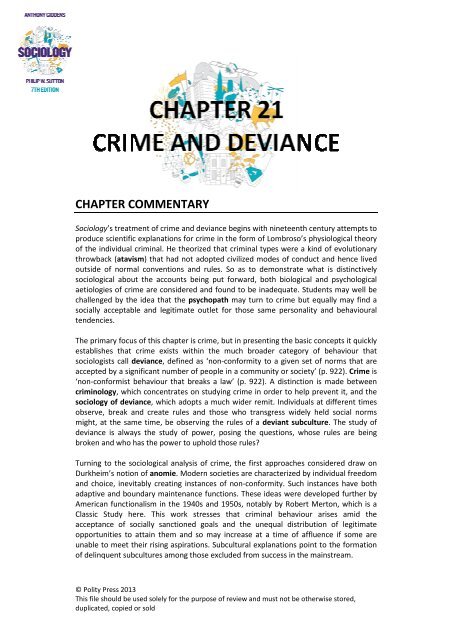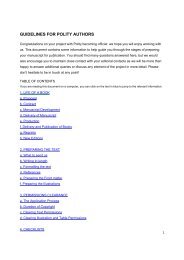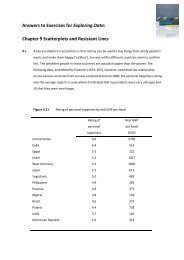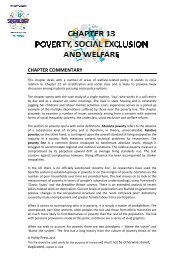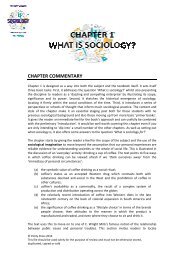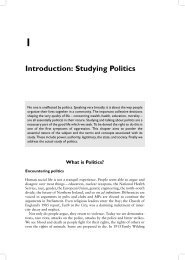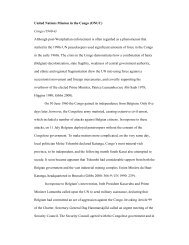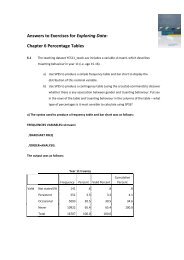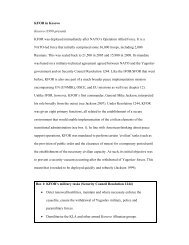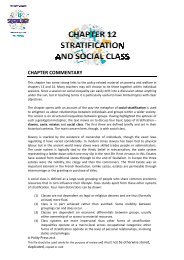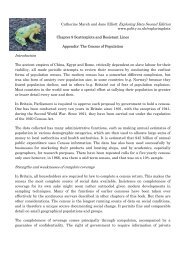Chapter 21 - Crime and Deviance - Polity
Chapter 21 - Crime and Deviance - Polity
Chapter 21 - Crime and Deviance - Polity
Create successful ePaper yourself
Turn your PDF publications into a flip-book with our unique Google optimized e-Paper software.
CHAPTER COMMENTARY<br />
Sociology’s treatment of crime <strong>and</strong> deviance begins with nineteenth century attempts to<br />
produce scientific explanations for crime in the form of Lombroso’s physiological theory<br />
of the individual criminal. He theorized that criminal types were a kind of evolutionary<br />
throwback (atavism) that had not adopted civilized modes of conduct <strong>and</strong> hence lived<br />
outside of normal conventions <strong>and</strong> rules. So as to demonstrate what is distinctively<br />
sociological about the accounts being put forward, both biological <strong>and</strong> psychological<br />
aetiologies of crime are considered <strong>and</strong> found to be inadequate. Students may well be<br />
challenged by the idea that the psychopath may turn to crime but equally may find a<br />
socially acceptable <strong>and</strong> legitimate outlet for those same personality <strong>and</strong> behavioural<br />
tendencies.<br />
The primary focus of this chapter is crime, but in presenting the basic concepts it quickly<br />
establishes that crime exists within the much broader category of behaviour that<br />
sociologists call deviance, defined as ‘non-conformity to a given set of norms that are<br />
accepted by a significant number of people in a community or society’ (p. 922). <strong>Crime</strong> is<br />
‘non-conformist behaviour that breaks a law’ (p. 922). A distinction is made between<br />
criminology, which concentrates on studying crime in order to help prevent it, <strong>and</strong> the<br />
sociology of deviance, which adopts a much wider remit. Individuals at different times<br />
observe, break <strong>and</strong> create rules <strong>and</strong> those who transgress widely held social norms<br />
might, at the same time, be observing the rules of a deviant subculture. The study of<br />
deviance is always the study of power, posing the questions, whose rules are being<br />
broken <strong>and</strong> who has the power to uphold those rules?<br />
Turning to the sociological analysis of crime, the first approaches considered draw on<br />
Durkheim’s notion of anomie. Modern societies are characterized by individual freedom<br />
<strong>and</strong> choice, inevitably creating instances of non-conformity. Such instances have both<br />
adaptive <strong>and</strong> boundary maintenance functions. These ideas were developed further by<br />
American functionalism in the 1940s <strong>and</strong> 1950s, notably by Robert Merton, which is a<br />
Classic Study here. This work stresses that criminal behaviour arises amid the<br />
acceptance of socially sanctioned goals <strong>and</strong> the unequal distribution of legitimate<br />
opportunities to attain them <strong>and</strong> so may increase at a time of affluence if some are<br />
unable to meet their rising aspirations. Subcultural explanations point to the formation<br />
of delinquent subcultures among those excluded from success in the mainstream.<br />
© <strong>Polity</strong> Press 2013<br />
This file should be used solely for the purpose of review <strong>and</strong> must not be otherwise stored,<br />
duplicated, copied or sold
<strong>Crime</strong> <strong>and</strong> <strong>Deviance</strong><br />
A further extension of Durkheim’s thought points to the positive outcomes for society in<br />
terms of both innovation <strong>and</strong> social solidarity of deviance maintained within acceptable<br />
bounds. Some theorists now argue that the boundaries have shifted to such an extent<br />
that socially disruptive levels of crime, particularly violent crime, have become<br />
normalized.<br />
Interactionist theories concentrate on how behaviours come to be defined as deviant.<br />
Labelling perspectives considers the social processes by which certain acts <strong>and</strong> actors<br />
become labelled as deviant. The same act, in different social settings, may be<br />
interpreted as ‘high spirits’ or ‘deviance’, categories normally imposed by the socially<br />
powerful upon the socially relatively powerless. The primary deviance of a transgressive<br />
act may have few consequences. However, once labelled as deviant all the actions of an<br />
individual become open to interpretation by others as deviant <strong>and</strong> individuals<br />
themselves may come to accept the label of deviant as central to their identity, a<br />
process which establishes secondary deviance. An upward spiral of deviancy<br />
amplification can be created at this point through deviancy amplification. The Classic<br />
Study of this process is Stan Cohen’s Folk Devils <strong>and</strong> Moral Panics (1972) which is given a<br />
thorough airing here.<br />
The new criminology of the 1970s saw deviance <strong>and</strong> criminality within the context of<br />
capitalist relationships of power. ‘Deviant’ behaviour from Black Power <strong>and</strong> Gay Rights<br />
activists was seen as a challenge to the political order, not as deviance. In the UK, the<br />
public panic over ‘mugging’ was reinterpreted as an ideological displacement of real<br />
problems in the sphere of production. Attention was drawn to the comparative lack of<br />
political emphasis placed upon white-collar crime compared with the petty crimes of the<br />
working class. The 1980s saw the emergence of New Left or Left Realism, which<br />
distanced itself from the more romantic str<strong>and</strong>s of the new criminology with a tendency<br />
to view deviants as heroes of the working class. Victim surveys showed that crime was a<br />
real problem for the socially excluded groups in impoverished communities, those on<br />
the margins of society being at a higher risk of crime. Left realists also used the concept<br />
of relative deprivation in their explanations. This approach argues for policing strategies<br />
that build trust with all groups in the local community.<br />
Control theories see human beings as fundamentally self-interested <strong>and</strong> rational <strong>and</strong><br />
hence willing to commit crimes if the chances of punishment are low, unless prevented<br />
by sufficiently strong personal bonds to society. Inadequate socialization means not<br />
everyone has the self-control which prevents criminal behaviour. Increasing affluence<br />
means more goods are available to be stolen <strong>and</strong> more homes are empty <strong>and</strong> vulnerable<br />
to crime during the working day. This approach is associated with Right Realism <strong>and</strong> an<br />
emphasis on crime prevention strategies focusing on making given crimes more difficult<br />
to commit, known as target hardening, along with zero tolerance policing. Together,<br />
these strategies are often called situational crime prevention – the attempt to prevent<br />
crime by focusing on the situation or environment rather than the offender <strong>and</strong> their<br />
motivations. These approaches may have the effect of simply changing the goods<br />
targeted by criminals <strong>and</strong> moving crime into less well-protected areas. The theory of<br />
‘broken windows’ suggests that there is a direct link between the appearance of<br />
disorder in a neighbourhood <strong>and</strong> the local level of crime: metaphorically <strong>and</strong> literally, a<br />
single broken window left unrepaired acts as a beacon to offenders <strong>and</strong> creates a<br />
downward spiral of crime in an area.<br />
184
<strong>Crime</strong> <strong>and</strong> <strong>Deviance</strong><br />
Patterns of crime <strong>and</strong> crime statistics are notoriously difficult to interpret, as not all<br />
crimes are reported, not all reported crimes recorded <strong>and</strong> the basis on which figures are<br />
collated <strong>and</strong> presented are not stable. Using the UK as a case study, it can be said that<br />
from the 1950s to the mid-1990s there was a steady increase both in levels of recorded<br />
crime <strong>and</strong> in public anxiety about crime. Victimization surveys such as the BCS reveal<br />
higher levels of crime than officially gathered statistics but still may under-record crimes<br />
such as domestic violence, which people may be unwilling or fell unable to report. Both<br />
official figures <strong>and</strong> victimization studies recorded from the mid-1990s onward reveal a<br />
general downward trend though levels of anxiety <strong>and</strong> fear of crime do not reflect this<br />
reduction.<br />
The sociology of deviance has tended to concentrate on men, in part reflecting the<br />
lower levels of recorded criminality among women <strong>and</strong> in part the processes of labelling<br />
which are less likely to name female behaviour as deviant. This pattern can be seen as<br />
the outcome of both the processes by which a crime becomes recorded <strong>and</strong> the real<br />
social conditions of women’s lives. Women have fewer opportunities than men to<br />
engage in many criminal activities, as all aspects of their behaviour in the public sphere<br />
remain controlled <strong>and</strong> contained in a way that men’s are not. Women in some<br />
circumstances also escape being labelled as deviant or criminal by evoking the ‘gender<br />
contract’, under which they accept the definition of themselves as erratic <strong>and</strong> in need of<br />
male protection. The extent to which women’s criminal behaviour will change along<br />
with wider changes in their social position remains unclear.<br />
The impact of changing gender patterns in society has also been invoked as an<br />
explanation of apparent increases in male criminality. High levels of male<br />
unemployment produce a crisis for young men in their transition to an adult masculinity.<br />
Criminal behaviour can offer a possible source of adult masculine identity.<br />
The crimes of domestic violence, sexual harassment, sexual assault <strong>and</strong> rape are<br />
overwhelmingly crimes committed by men against women. Only a small proportion of<br />
rapes come to the attention of the authorities, although the number has increased as<br />
police <strong>and</strong> courts have been made more aware of, <strong>and</strong> more sensitive to, these issues.<br />
Rape is not about sexual desire but about violence, power <strong>and</strong> control in a sexualized<br />
way. All women are affected by rape as fear of it limits freedom on the streets <strong>and</strong> can<br />
even create anxiety when home alone. Just as all women are expected to modify their<br />
behaviour, or risk being seen as ‘asking for it’, so too are gay men <strong>and</strong> lesbians who are<br />
publicly open about their sexuality. Youth crime, as Cohen <strong>and</strong> others have argued, is an<br />
area which crystallizes wider social concerns <strong>and</strong> the introduction of Anti-Social<br />
Behaviour Orders (ASBOs) <strong>and</strong> similar initiatives can be seen to criminalize low-level<br />
deviance.<br />
The chapter now turns to consider middle-class crimes, which run counter to popular<br />
perceptions of both crime <strong>and</strong> criminality. White-collar crime covers a range of illegal<br />
activities open to those with professional occupations, notably in the financial sector,<br />
<strong>and</strong> refers to offences which are not sanctioned by companies <strong>and</strong> may harm them, such<br />
as fraud <strong>and</strong> embezzlement. Corporate crime covers all of those harmful activities by<br />
corporations in pursuit of their own interests such as pollution, mislabelling <strong>and</strong><br />
violations of health <strong>and</strong> safety legislation. In these cases, the gap between the<br />
perpetrator <strong>and</strong> the victim of crime is large, but these are not victimless crimes <strong>and</strong> the<br />
victims are often the most vulnerable in society.<br />
185
<strong>Crime</strong> <strong>and</strong> <strong>Deviance</strong><br />
The next section of the chapter turns to consider responses to crime. The UK <strong>and</strong> USA<br />
are countries particularly wedded to custodial sentencing in response to criminal<br />
behaviour. High rates of recidivism call into question its effectiveness as a tool for either<br />
rehabilitation or deterrence <strong>and</strong> in part account for recent interest in restorative justice<br />
approaches. Recent policy has seen a move towards restorative justice <strong>and</strong> community<br />
punishments though sociologists argue that we should not see these as simple solutions<br />
to the prevention of crime <strong>and</strong> deviance. Restorative justice seeks to raise awareness<br />
among offenders of the impact of their crimes on victims.<br />
A further aspect of economic <strong>and</strong> political globalization is the international spread of<br />
organized crime. Such crime represents multimillion-dollar international trade, often<br />
linked with the illegal narcotics industry <strong>and</strong> masked by legitimate business activity<br />
based in areas of low risk for the criminals such as the former Soviet Union. Cybercrime<br />
has grown along with the Internet, <strong>and</strong> operates outside geographical constraints,<br />
posing particular challenges for international law <strong>and</strong> law enforcement agencies. Wall’s<br />
distinction between first, second <strong>and</strong> third (or ‘true) cybercrimes is adopted to show<br />
how some crimes simply make use of the new ICTs whilst others only become possible<br />
with its rise.<br />
TEACHING TOPICS<br />
1. Learning <strong>and</strong> labelling<br />
Much criminal behaviour, whilst breaking the rules of society, is behaviour which obeys<br />
the rules of the subculture within which it is located. Such behaviour is learned through<br />
processes of socialization, <strong>and</strong> the acceptance of a deviant label may promote the<br />
solidarity of the subcultural group. This topic builds upon the section ‘Explaining crime<br />
<strong>and</strong> deviance: sociological theories’.<br />
2. Victims <strong>and</strong> perpetrators<br />
Dimensions of social inequality are linked in a variety of ways to crime <strong>and</strong> criminality.<br />
The section on ‘Conflict theories <strong>and</strong> the new criminology’ explores some class<br />
dimensions, while the section ‘Victims <strong>and</strong> perpetrators of crime’ also touches on class<br />
but explores more thoroughly issues of gender <strong>and</strong> sexuality.<br />
3. Young people <strong>and</strong> prison<br />
This theme links together two areas raised in the chapter: ‘Youth <strong>and</strong> crime’ <strong>and</strong> ‘Prisons<br />
<strong>and</strong> punishment’ <strong>and</strong> builds upon Using Your Sociological Imagination <strong>21</strong>.1’s example of<br />
the death in custody of Adam Rickwood in the UK context.<br />
ACTIVITIES<br />
Activity 1: Learning <strong>and</strong> labelling<br />
Using marijuana is illegal in Britain. For many people, though, the use of marijuana is<br />
part of their everyday life. These people are acting criminally <strong>and</strong> would be seen by<br />
many as ‘deviants’, but within their own subcultures their behaviour is seen as normal<br />
<strong>and</strong> is governed by taken-for-granted rules of interaction in much the same way as other<br />
186
<strong>Crime</strong> <strong>and</strong> <strong>Deviance</strong><br />
aspects of social life. Like other aspects of social life using marihuana is learned<br />
behaviour which the individual is taught through processes of socialization.<br />
Howard Becker’s classic Outsiders, details the stages in becoming a marijuana user. He<br />
identifies three key stages in the transition from being someone who has reached the<br />
point of being willing to try marijuana to becoming a user of marijuana for pleasure. The<br />
stages are: learning the technique, learning to perceive the effects <strong>and</strong> learning to enjoy<br />
the effects. This study was conducted among musicians in the United States in the early<br />
1960s. At that time smoking marijuana was an important element in the subculture of<br />
jazz musicians <strong>and</strong> was woven into the subcultural whole through the use of language<br />
<strong>and</strong> the rituals of usage. This extract is taken from the section in Becker’s book,<br />
‘Learning to Enjoy the Effects’, <strong>and</strong> deals with the role of experienced marijuana users in<br />
teaching novices to redefine their sometimes unpleasant <strong>and</strong> frightening first<br />
experiences of marijuana use into something pleasurable:<br />
An experienced user describes how he h<strong>and</strong>les newcomers to marijuana use:<br />
Well, they get pretty high sometimes. The average person isn’t ready for<br />
that, <strong>and</strong> it is a little frightening to them sometimes. I mean, they’ve been<br />
high on lush [alcohol], <strong>and</strong> they don’t know what's happening to them.<br />
Because they think they’re going to keep going up, up, up till they lose their<br />
minds or begin doing weird things or something. You have to like reassure<br />
them, explain to them that they’re not really flipping or anything, that<br />
they’re gonna be all right. You have to just talk them out of being afraid.<br />
Keep talking to them, reassuring, telling them it's all right. And come on with<br />
your own story, you know: ‘The same thing happened to me. You’ll get to<br />
like that after a while.’ Keep coming on like that; pretty soon you talk them<br />
out of being scared. And besides they see you doing it <strong>and</strong> nothing horrible is<br />
happening to you, so that gives them more confidence.<br />
The more experienced user may also teach the novice to regulate the amount<br />
he smokes more carefully, so as to avoid any severely uncomfortable symptoms<br />
while retaining the pleasant ones. Finally, he teaches the new user that he can<br />
‘get to like it after a while.’ He teaches him to regard those ambiguous<br />
experiences formerly defined as unpleasant as enjoyable […]<br />
In short, what was once frightening <strong>and</strong> distasteful becomes, after a taste for it<br />
is built up, pleasant, desired <strong>and</strong> sought after. Enjoyment is introduced by the<br />
favorable definition of the experience that one acquires from others. Without<br />
this, use will not continue, for marijuana will not be for the user an object he<br />
can use for pleasure.<br />
(Howard Becker, Outsiders, New York: Free Press, 1963, pp. 55–6)<br />
1. How is this process an induction into both deviance <strong>and</strong> conformity?<br />
Activity 2: Victims <strong>and</strong> perpetrators<br />
Until the 1950s, male homosexuality was a criminal act in the UK. The forces of law <strong>and</strong><br />
order were charged to police <strong>and</strong> punish the act. Until the 1970s, homosexuality was<br />
seen as an illness to be treated. In the fairly recent past male homosexuality has been<br />
187
<strong>Crime</strong> <strong>and</strong> <strong>Deviance</strong><br />
variously seen as a sickness, a deviance <strong>and</strong> an evil. Today, some individuals <strong>and</strong> groups<br />
retain these views, even though homosexuality is, no longer a crime.<br />
The question of crime <strong>and</strong> homosexuality now focuses on those who would express<br />
their dislike <strong>and</strong> disapproval of homosexuality through violent means. The Criminal<br />
Justice Act, 2003, permits judges to increase sentences in the context of ‘hate crimes’<br />
including homophobic attacks. Read the subsection ‘<strong>Crime</strong>s against homosexuals’ (pages<br />
946-7), which outlines a paper by Diane Richardson <strong>and</strong> Hazel May (1999). Now read this<br />
extract from that paper:<br />
Consideration of how we underst<strong>and</strong> <strong>and</strong> explain violence differently in relation<br />
to who the victim is, rather than the circumstances in which the violence occurs,<br />
raises the question of the social recognition <strong>and</strong> worth accorded certain<br />
individuals or social groups <strong>and</strong>, related to this, the degree to which they are<br />
considered to have ‘lives worth living’ …<br />
The focus on lesbians <strong>and</strong> gay men is extremely useful in highlighting how<br />
interpretations of violence are mediated through notions of culpability <strong>and</strong><br />
victimisation. As a marginalised <strong>and</strong> stigmatised group within society, lesbians<br />
<strong>and</strong> gay men are unlikely to be construed as ‘innocent’ victims. On the contrary,<br />
the idea of the ‘homosexual’ as dangerous, a threat both to individuals they<br />
have contact with, especially children, <strong>and</strong> to national security <strong>and</strong> social order<br />
has a long history … Analysis of the meanings attributed to violence towards<br />
lesbians <strong>and</strong> gay men, therefore, helps to make explicit the normative processes<br />
by which we define someone as an ‘undeserving’ or ‘deserving’ victim …<br />
… The idea that the public existence of ‘homosexuals’ represents some form of<br />
provocation, which renders violence <strong>and</strong> harassment intelligible, is evident in<br />
institutional as well as informal assessments of public violence. This is<br />
supported by the literature on homophobic violence … which draws attention<br />
to the failure of the police to acknowledge the significance of recording ‘sexual<br />
orientation’ among the reasons which motivate attackers to abuse <strong>and</strong> kill, <strong>and</strong><br />
the reluctance of the courts to impose harsh sentences on the perpetrators of<br />
such crimes.<br />
(Diane Richardson <strong>and</strong> Hazel May, ‘Deserving victims?: sexual status <strong>and</strong> the<br />
social construction of violence’, Sociological Review, 1999, pp. 308–31)<br />
1. What other groups are sometimes seen to be ‘asking for it’?<br />
2. In what ways is this analysis of the position of gay men <strong>and</strong> lesbians as victims of<br />
crime similar to the analysis of ethnic minority groups as victims of crime?<br />
3. Could there be a link between anti-gay crime <strong>and</strong> the ‘crisis of masculinity’?<br />
Activity 3: Young people <strong>and</strong> prison<br />
The section ‘Youth <strong>and</strong> crime’ points to the ways in which public fears about a general<br />
social <strong>and</strong> moral breakdown become focused upon the question of youth crime. These<br />
fears far outstrip the reality of youth crime <strong>and</strong> often focus upon deviant rather than<br />
strictly criminal acts. The ‘law <strong>and</strong> order’ emphasis upon drug use <strong>and</strong> the use of Anti-<br />
Social Behaviour Orders (ASBOs) can have the effect of criminalizing behaviour which in<br />
other ways can be seen as a normal part of growing up. Read that section now.<br />
188
<strong>Crime</strong> <strong>and</strong> <strong>Deviance</strong><br />
The section ‘Prisons <strong>and</strong> punishment’ points to the tensions which create a situation<br />
where the prison population in the UK is growing <strong>and</strong> is significantly higher as a<br />
proportion of the population than other European countries, despite evidence which<br />
strongly suggests that prison is not a rehabilitative or deterrent force <strong>and</strong> may, in fact,<br />
contribute to hardening the criminality of inmates. Read that section now <strong>and</strong> pay<br />
particular attention to the case of Adam Rickwood (pages 956-7).<br />
Barry Goldson conducted research over a 12-month period in 2001 <strong>and</strong> 2002<br />
into young people (he prefers the term ‘children’) held in locked institutions.<br />
Locked institutions take two different forms: Secure Units, run by local<br />
authorities <strong>and</strong> the Department of Health, where young people deemed to be<br />
‘at risk’ can be placed; <strong>and</strong> Young Offender Institutions, managed by the prison<br />
service <strong>and</strong> the Home Office, which hold young people charged or convicted<br />
with criminal offences. In fact, the backgrounds <strong>and</strong> circumstances of the young<br />
people in these two types of institution share much in common. The extract<br />
below refers specifically to Young Offender Institutions. Some children<br />
interviewed for the study reported negative treatment from the prison staff.<br />
Even if prison staff were willing to meet the inmates’ needs, Goldson found that<br />
understaffing meant that in practice staff were unable to give them appropriate<br />
care. For Goldson, the consequences of such neglect for children are apparent:<br />
It hurts all the time. All you do is miss your family <strong>and</strong> you can’t hack it<br />
sometimes. I wouldn’t send kids to a place like this. (Boy, 16 years)<br />
I felt very lonely <strong>and</strong> that, very lonely really. You are on your own <strong>and</strong> there<br />
is no one to talk to. All you can do is think <strong>and</strong> it really winds you up. I had<br />
no one to speak to <strong>and</strong> it all built-up <strong>and</strong> I started thinking that I can’t take<br />
anymore. (Boy, 16 years)<br />
Worse still, young offender institutions are not just neglectful, they are sites of<br />
concentrated bullying in all its forms – physical assault, sexual assault, verbal<br />
abuse, racist abuse ad assault, intimidation, extortion <strong>and</strong> theft. Prison staff<br />
explain:<br />
It comes in waves, it depends who’s on the wing. You get kids bullying each<br />
other, you get staff bullying kids <strong>and</strong> you get staff bullying staff. … Outside<br />
the kids can get status in lots of ways. In here status is measured in<br />
different ways: fear <strong>and</strong> respect become very confused. (Female prison<br />
officer)<br />
I think that it occurs all the time in different ways. … Especially with verbal<br />
bullying, or just an attitude which is a form of bullying, people don’t always<br />
see it, particularly staff I would say. They call it discipline but it’s really<br />
bullying, it’s an abuse of power. (Male prison nurse)<br />
In other settings such behaviour would be called child abuse.<br />
(Barry Goldson, ‘Victims or threats? Children, care <strong>and</strong> control’, in Janet Fink (ed.),<br />
Care: Personal Lives <strong>and</strong> Social Policy, Bristol: The Policy Press in association with<br />
the Open University, 2004, pp. 103–4)<br />
189
<strong>Crime</strong> <strong>and</strong> <strong>Deviance</strong><br />
1. In Sociology the term ‘youth’ is used; in the commentary here, ‘young people’; <strong>and</strong><br />
by Goldson himself, ‘children’. Does the choice of term affect the way you think<br />
about the situation of these 15- <strong>and</strong> 16-year olds? How might labelling theorists<br />
interpret the choice of language?<br />
2. If prison does not work as a mechanism for rehabilitation or deterrence, what other<br />
social purposes may it serve, particularly with regard to young people?<br />
3. What are the similarities <strong>and</strong> differences between the example of Adam Rickwood<br />
<strong>and</strong> the young people in the Goldson extract?<br />
REFLECTION & DISCUSSION QUESTIONS<br />
Learning <strong>and</strong> labelling<br />
What workplace crimes are accepted as normal behaviour?<br />
How might being labelled as deviant affect the interpretation of an individual’s<br />
actions?<br />
How can an activity once seen as deviant become a societal norm?<br />
How does differential association affect both the opportunities to become deviant<br />
<strong>and</strong> the likelihood of being labelled as such?<br />
Victims <strong>and</strong> perpetrators<br />
Why do women <strong>and</strong> men commit different kinds of crime?<br />
Will women have gained equality when they are as criminal as men?<br />
Why might the rate of sexual offences be underreported?<br />
Should the police collect statistics which identify the sexuality of the victim?<br />
Young people <strong>and</strong> prison<br />
What might a young person learn during a custodial sentence?<br />
Could Young Offender Institutions be made more effective as a mechanism of<br />
rehabilitation?<br />
What alternative non-custodial sentence could be used with young people?<br />
ESSAY QUESTIONS<br />
1. Both actual crime <strong>and</strong> crime statistics are the products of social inequalities, albeit in<br />
different ways. Discuss.<br />
2. In what ways are we all rule-breakers <strong>and</strong> rule-creators?<br />
3. Why does society find it easier to accept women as the victims rather than the<br />
perpetrators of violent crime, <strong>and</strong> members of ethnic minority groups as<br />
perpetrators rather than victims?<br />
MAKING CONNECTIONS<br />
Learning <strong>and</strong> labelling<br />
This topic draws together interactionist concerns, discussed in <strong>Chapter</strong> 8, <strong>and</strong> issues of<br />
socialization through the life course from <strong>Chapter</strong> 9. Labelling <strong>and</strong> deviance feature<br />
190
<strong>Crime</strong> <strong>and</strong> <strong>Deviance</strong><br />
again in the context of anti-school sub-cultures in <strong>Chapter</strong> 20 <strong>and</strong> are clearly applicable<br />
to the social construction of disability from <strong>Chapter</strong> 11 <strong>and</strong> age-based categories from<br />
<strong>Chapter</strong> 9.<br />
Victims <strong>and</strong> perpetrators<br />
This topic aims to open up the relationship between the social construction of the<br />
deviant actors ‘perpetrator’ <strong>and</strong> ‘victim’ <strong>and</strong> broader social constructions of gender,<br />
sexualities <strong>and</strong> ethnic identities: <strong>Chapter</strong>s 15 <strong>and</strong> 16 are therefore particularly useful.<br />
Young people <strong>and</strong> prison<br />
This topic asks students to make links between arguments about youth crime <strong>and</strong> prison<br />
<strong>and</strong> draw upon both functionalism <strong>and</strong> labelling theory in their answers. It provides a<br />
good example of the social construction of ‘youth’ <strong>and</strong> can be linked to chapter 9. More<br />
subtle links can also be made to theories of childhood development from the same<br />
chapter. Another route would be to explore functionalist accounts of deviance linked to<br />
the discussion of Durkheim in <strong>Chapter</strong> 1 as well as Foucault’s accounts of modern<br />
organization <strong>and</strong> surveillance in <strong>Chapter</strong>s 3 <strong>and</strong> 19.<br />
SAMPLE SESSION<br />
Learning <strong>and</strong> labelling<br />
Aims<br />
To show that deviance is not a property of behaviour but of the social meaning of<br />
behaviour<br />
To show that deviant behaviour follows group norms<br />
Outcome: By the end of the session students will be able to:<br />
1. Explain the terms ‘differential association’ <strong>and</strong> ‘labelling theory’<br />
2. Give examples of how deviant behaviour is learned <strong>and</strong> follows social rules.<br />
3. Summarize <strong>and</strong> organise information from a number of sources<br />
Preparatory tasks<br />
Read the section ‘Explaining crime <strong>and</strong> deviance: sociological theories’. Read the<br />
extract provided from Becker. Think about any examples of subcultural behaviour<br />
which you have been similarly socialized into.<br />
Classroom tasks<br />
1. Tutor introduces exercises <strong>and</strong> explains assessment task. (5 minutes)<br />
2. Divide the class into small groups <strong>and</strong> issue each with flip-chart paper <strong>and</strong> marker<br />
pens. Each group should elect both a scribe <strong>and</strong> a reporter to feed back on the<br />
group’s behalf:<br />
(a) The drug users Becker discussed have their own vocabulary: write down any<br />
terms from contemporary youth culture that these 1960s deviants would have<br />
trouble underst<strong>and</strong>ing?<br />
(b) Other than illegal drugs, are there any aspects of youth culture that you have<br />
to ‘learn to like’? (a + b = 15 minutes)<br />
3. Groups feedback <strong>and</strong> flip-charts are placed on the wall for the rest of the session. (5<br />
minutes)<br />
191
<strong>Crime</strong> <strong>and</strong> <strong>Deviance</strong><br />
4. Tutor poses the question ‘When does drinking alcohol become deviant?’ In the<br />
same groups students are encouraged to discuss the question, take a pen each <strong>and</strong><br />
write down with minimal editing any ideas as they come to them. (10 minutes)<br />
5. The flip-charts are displayed on the wall with no formal feedback. For the rest of<br />
the session students have the opportunity to w<strong>and</strong>er round <strong>and</strong> read the sheets<br />
taking any notes as they go.<br />
Assessment task<br />
Write a report which summarizes the answers from all groups to the questions above.<br />
192


